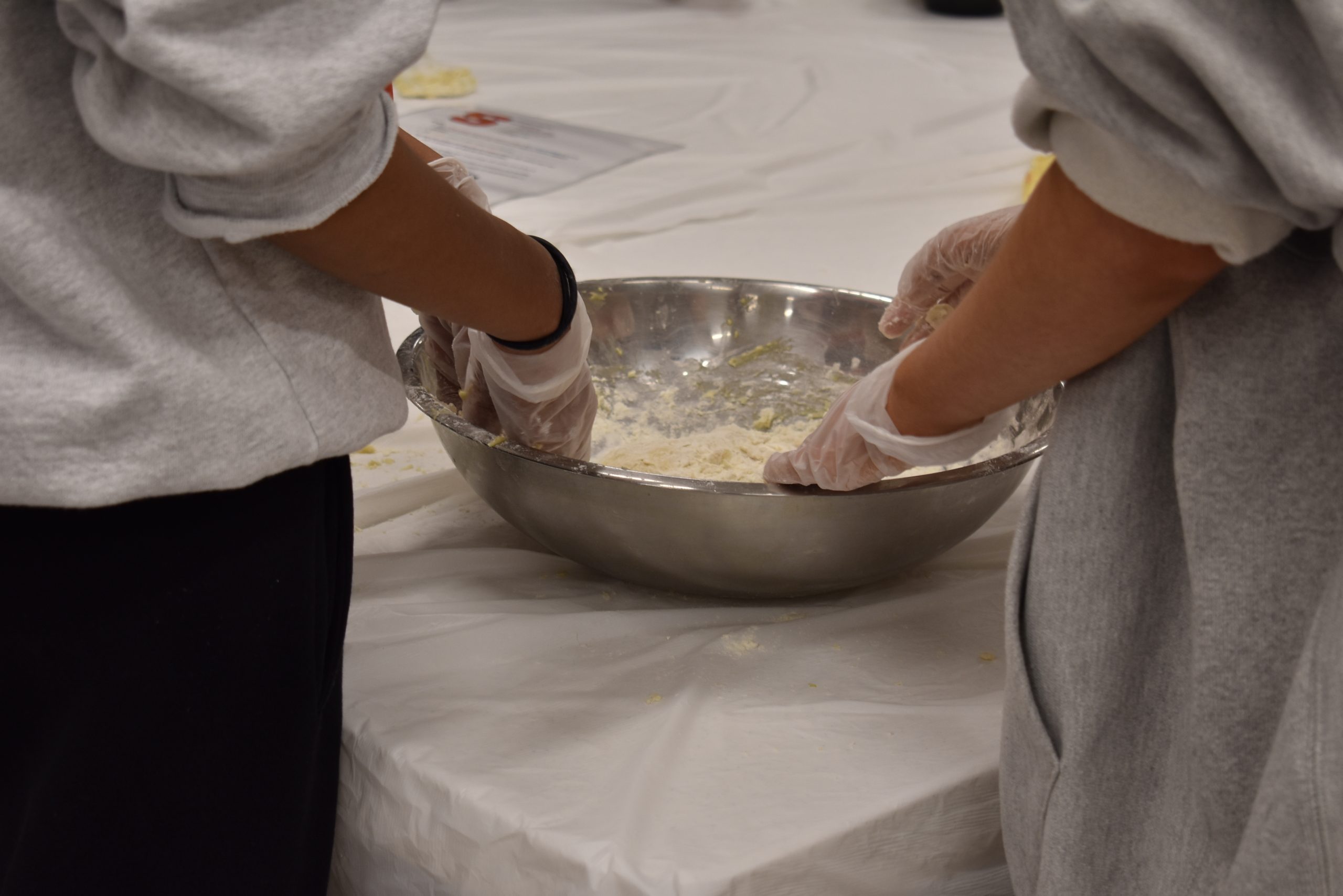Challah creates connection for all kinds of students
Challah bakes community and connection
The smell of yeast filled the basement of SU’s Winnick Hillel Center. Students huddled around tables wearing customized aprons and taught each other how to make challah, a traditional Jewish bread.
Some students had a cultural connection to challah, others were there to get their volunteer hours, but every student agreed on one thing.
“It’s just something yummy to eat and celebrate,” said Sarah Pivawer.
Challah for Hunger, a student organization on campus, bakes and sells challah to raise money to combat hunger, but the bakes bring more than just tasty bread. The act of mixing, kneading, and baking has created a sense of community that has gathered around challah for centuries.
President Abby Davis started the club in 2020, her sophomore year. She heard that the organization existed before, but the coronavirus pandemic forced the club to dissolve. Craving the community of her Jewish heritage, Davis decided to start the club again and invited her friends to bake some challah. One year later, the club raised over $1,000 from selling the bread.

Modern challah is known to be a sweet and shiny braided bread that goes great with French toast. In the Torah, challah was the word used for the bread given to priests and didn’t refer to any particular shape or taste. Today, challah is known for its use in various Jewish rituals, including Shabbat dinners and Rosh Hashanah.
Jonah Srulevich is no stranger to challah, making him the perfect dough coordinator.
“We’d have Shabbat every Friday night, and my mom would always make challah and I’d make it with her beforehand,” Srulevich said. “It just reminds me of home, connection and warm, positive feeling.”
For Joshua Spodek, the day-of coordinator for Challah for Hunger, eating challah reminded him of Shabbat dinners with his family. He would say the prayer over the bread and rip-off pieces to pass to others around the table.
“I was notoriously known for not ripping large enough pieces. So, I’d just give the really small pieces to my family members and then keep all of it for me,” Spodek said.
According to Hillel International, 17 percent of Syracuse University’s student population is Jewish. Challah for Hunger is one of many Jewish student organizations that brings together students of all backgrounds for a common cause.
The organization welcomes non-Jewish participants who feel that same sense of community. Ellany Tsin started going to Challah for Hunger bakes to get volunteer hours for her service fraternity, but the people involved have brought her back again and again. Tsin is not Jewish, but she still felt a sense of connection to Challah by going to the bakes.
“You don’t have to be a part of the Jewish community to be a part of the community,” she said.
For Srulevich, challah has always been a part of his personal life, but now it’s created new memories for him in college.
“It’s something that connects you, no matter where you’re from or your background. You don’t even have to be Jewish,” he said. “Everybody likes it.”
Challah Recipe
Dough Ingredients:
- 1 1/2 cup lukewarm water
- 1 packet active dry yeast
- 1 teaspoon sugar
- 1 large egg
- 1 large egg
- 3 large egg yolks
- 1/3 cup honey
- 2 tbsp canola oil
- 2 teaspoons salt
- 4 1/2-6 cups all-purpose flour
- 1/4 cup cornflakes (optional)
Egg Wash Ingredients:
- 1 large egg
- 1 tablespoon cold water
- 1/2 teaspoon salt
Recipe:
-
- Pour ¼ cup of the lukewarm water (about 110 degrees) into a large mixing bowl. Add 1 packet of active dry yeast and 1 tsp of sugar to the bowl, stir to dissolve. Wait 10 minutes to proof.
- Once your yeast has activated, add the remaining 1 ¼ cup lukewarm water to the bowl along with the egg, egg yolks, honey, oil, and salt. Use a whisk to thoroughly blend the ingredients together.
- Begin adding the flour to the bowl by half-cupfuls, stirring with a large spoon each time flour is added. When the mixture becomes too thick to stir, use your hands to knead. Continue to add flour and knead the dough until it’s smooth, elastic, and not sticky.
- Place a saucepan full of water on the stove to boil. At the same time, remove the dough from your mixing bowl and wash out the bowl. Grease the bowl with oil. Push the dough back into the bottom of the bowl, then flip it over so that both sides are slightly moistened by the oil.
- Cover the bowl with a clean, damp kitchen towel. Place the dough in a warm, moist environment to allow to rise. Let the dough rise for 1 hour, or until the dough doubles in size.
- Take the dough bowl out and punch it down several times to remove air pockets.
- Place it back inside the oven and let it rise for 1 hour longer, or until the dough doubles in size.
- Take the dough out of the oven. Punch the dough down into the bowl a few times, then turn the dough out onto a floured surface. Knead for a few minutes, adding flour as needed to keep the dough from feeling sticky.
- Now your dough is ready to braid. If you plan to separate and bless the challah, do it prior to braiding. After you’ve braided your challah, place it on a cookie sheet lined with parchment paper.
- Prepare your egg wash by beating the egg, salt and water till smooth. Use a pastry brush to brush a thin layer of the mixture onto the visible surface of your challah. Reserve the leftover egg wash.
- Let the braid rise 30 to 45 minutes longer. Preheat oven to 350 degrees F.
- Bake for 20 minutes, then take the bread out of the oven and add another layer of egg wash.
- Turn the tray around, so the opposite side is facing the front, and put the tray back into the oven for another 20 minutes.
- Once the challah is browned to your liking, take the tray out and tent it with foil, then place it back in the oven. Remove the foil for the last 2 minutes of baking time. Take the challah out of the oven.
- Let cool and enjoy!
Adapted from Tori Avey





